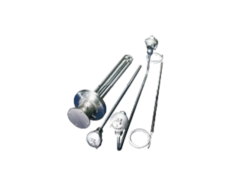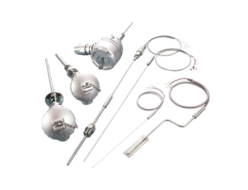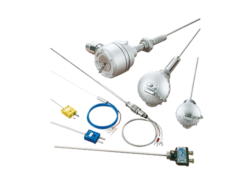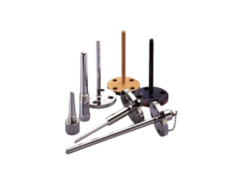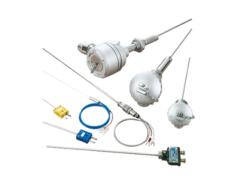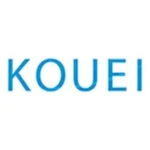Okazaki Manufacturing Company
Okazaki Protection Tube Type Thermocouples/Coated Thermocouples
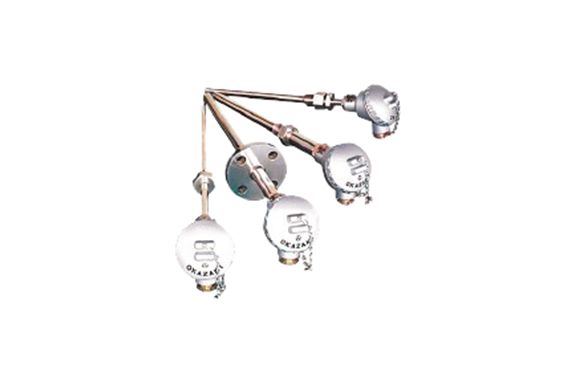
Manufacturer: Okazaki Manufacturing Company
Specifications
| Types | Features | |
|---|---|---|
| Symbols | Configuration Materials | |
| B | Pt-30Rh/Pt-6Rh | They are the thermocouples in combination of a positive leg made of platinum (70%) rhodium (30%) alloy and a negative leg that is composed of platinum (94%) rhodium (6%) alloy. They have better heat-resistance and mechanical strength than type R thermocouples, and the heat-resistant temperature is up to 1,800℃. |
| R | Pt-13Rh/Pt | Thermocouples in combination of a positive leg made of platinum (87%) rhodium (13%) alloy and a negative leg that is composed of pure platinum. They generally have good accuracy with excellent heat resistance and stability in an oxidizing atmosphere. They have a tendency to be weak in a reducing atmosphere or against metal vapor. |
| S | Pt-10Rh/Pt | Thermocouples in combination of a positive leg made of platinum (90%) rhodium (10%) alloy and a negative leg that is composed of pure platinum. |
| N | Ni-Cr-Si/Ni-Si | They are called Nicrosil (positive leg) Nisil (negative leg), and their composition and characteristics are very similar to type K thermocouples. They are an improved version of type K thermocouples, and the added amount of Si is larger and the heat resistance is better. |
| K | Ni-Cr/Ni-AI | They are the thermocouples in combination of a positive leg made of alloy of mainly nickel and chrome and a negative leg that is composed of an alloy of mainly nickel. They are used the most frequently for industrial purposes, and they show great resistance in an oxidizing atmosphere; however, they are weak in a reducing atmosphere and cannot be used in the atmospheres characterized by carbon monoxide, sulfurous acid gas, hydrogen sulfide, etc. |
| E | Ni-Cr/Cu-Ni | They are the thermocouples in combination of a positive leg made of type K thermocouples and a negative leg that is composed of type J thermocouples. They have extremely large thermo-electromotive force for temperature and are suitable to be used in an oxidizing atmosphere. |
| J | Fe/Cu-Ni | They are the thermocouples in combination of a positive leg made of iron and a negative leg that is composed of an alloy of mainly copper and nickel. They are strong in a reducing atmosphere and robust for hydrogen and carbon. They cannot be used in an oxidizing atmosphere since iron si quickly oxidized. They are relatively cheap so that they are suitable for medium temperatures. |
| T | Cu/Cu-Ni | They are thermocouples in combination of a positive leg made of copper and a negative leg that is composed of an alloy of mainly copper and nickel. They show high accuracy at 300℃ or lower and are especially suitable for low temperatures of -200 to 100℃. They are also suitable for a weak oxidizing and reducing atmosphere. |
Materials and Standard Dimensions of Metal Protection Tubes
| Types JIS code is in ( ). | Material code | Dimension (φ/mm) | Max. length (mm) | Common use temperature limit(℃)※1 | Features | |
|---|---|---|---|---|---|---|
| Outer diameter | Inner diameter | |||||
| 304SS (SUS304) | A | 10 | 7 | 2000 | 900 | Excellent at heat/acid/alkali resistance. Weak against sulfur and reducing gas. |
| 12 | 9 | |||||
| 15 | 11 | 3950 | ||||
| 21.7 | 15.7 | |||||
| 316SS (SUS316) | C | 10 | 7 | 2000 | 900 | Heat/acid/alkali resistance is the same as the resistance of 304SS; however, corrosion resistance is excellent at high temperatures. |
| 12 | 9 | |||||
| 15 | 11 | 3950 | ||||
| 21.7 | 15.7 | |||||
| 316LSS (SUS316L) | CL | 10 | 7 | 2000 | 900 | The amount of C is less than that in 316SS, and the material has grain-boundary corrosion resistance. |
| 12 | 9 | |||||
| 15 | 11 | 3950 | ||||
| 21.7 | 16.1 | |||||
| 310S SS (SUS310S) | D | 15 | 11 | 3950 | 1000 | It is heat-resistant steel with a high content rate of Ni-Cr and great at oxidizing atmospheres at high temperature. |
| 21.7 | 16.1 | |||||
| 27.2 | 21.4 | |||||
| SUH446 | P | 21.7 | 16.1 | 3950 | 1000 | It is heat-resistant with 27Cr steel and strong against reducing flame and sulfur gas. |
| 4C54 (SANDVIK P4) | 21.3 | 16 | ||||
| 26.9 | 21.6 | |||||
| UMCo50 | U | 22 | 16 | 3950 | 1150 | It is a cobalt-base alloy, which has strong heat-resistance/wear-resistance and is also strong for sulfur gas. |
| 27 | 21 | |||||
| INCONEL600 (NCF600eq) | B | 22 | 16 | 3950 | 1050 | It is strong in both a high temperature oxidizing and reducing atmosphere. |
| TITANIUM | T | 15 | 11 | 3950 | 250 | Corrosion resistance is extremely excellent at low temperatures; however, the material becomes fragile with oxidation at high temperatures. |
| 17.3 | 12.7 | |||||
| 21.7 | 16.1 | |||||
| 27.2 | 21.6 | |||||
Material and Standard Dimensions of Non-metal Protection Tubes
| Types | Material code | Dimension(φmm) | Max. length (mm) | Common use temperature limit(℃)※1 | Features | |
|---|---|---|---|---|---|---|
| O.D. Outer diameter | I.D. Internal diameter | |||||
| Alumina quality | P1 | 8 | 5 | 1000 | 1500 | It is excellently stable in oxidizing/reducing atmospheres at a high temperature equivalent to JIS R1401 PT1 and excellent in corrosion resistance at a high temperature. It is suitable for measuring temperature within a furnace of 1,600℃ or higher and molten metal. |
| 10 | 6 | |||||
| 13 | 9 | |||||
| 15 | 11 | |||||
| 17 | 13 | |||||
| 20 | 15 | |||||
| High-alumina quality | P0 | 8 | 5 | 1000 | 1600 | It has excellent heat resistance/corrosion resistance/electric insulation/mechanical strength equivalent to JIS R1401 PT0. It is excellent in wear resistance because of high hardness. |
| 10 | 6 | |||||
| 13 | 9 | |||||
| 15 | 11 | |||||
| 20 | 16 | |||||
| 15 | 6 | |||||
| 20 | 10 | |||||
| Silicon carbide Refractory | GK | 20 | 12 | 1000 | 1600 | It has high refactoriness and a large heat conduction rate. It is not easily affected by zinc, aluminum, lead, acids and alkalis. It is robust for rapid heating/cooling and excellent in spalling resistance. It is suitable for outer tubes for doubled protection tubes. |
| by25 | 17 | |||||
| 30 | 20 | |||||
| 35 | 25 | |||||
| 40 | 25 | |||||
| 45 | 30 | |||||
| 50 | 30 | |||||
| 60 | 40 | |||||
※1The common use temperature limits were described referring to JIS and manufacturer’s catalog; therefore, they are not guaranteed values.

